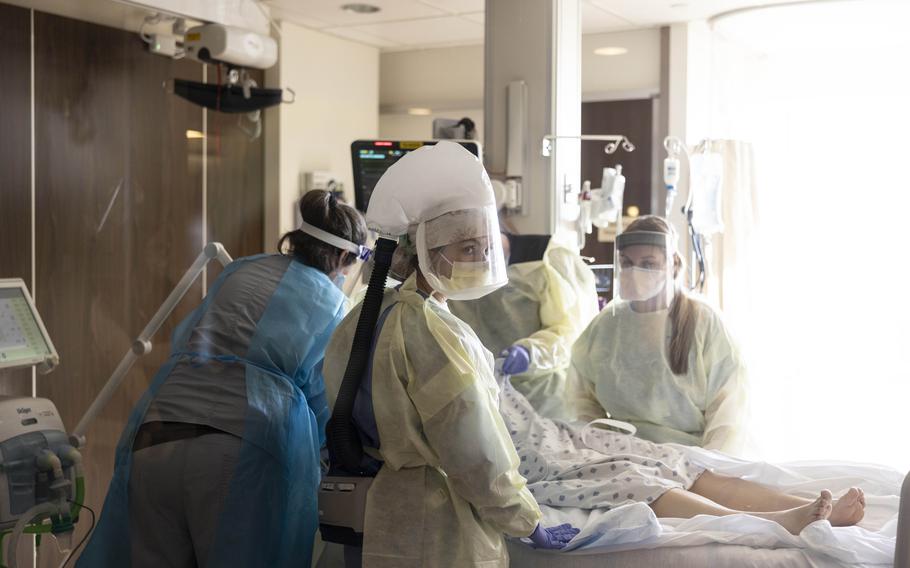
A team of nurses and physicians transfers a patient with COVID-19 into the intensive care unit at St. Cloud Hospital in Minnesota in November 2021. (Jenn Ackerman/for The Washington Post)
Stars and Stripes is making stories on the coronavirus pandemic available free of charge. See more stories here. Sign up for our daily coronavirus newsletter here. Please support our journalism with a subscription.
Early this year, the acting head of the Food and Drug Administration offered a stern and ominous warning: Most Americans were going to contract the coronavirus.
Americans now report that we have reached this milestone. And the numbers point to the virus taking a disproportionate toll on Republicans.
In a new Monmouth University poll, 52% of Americans say they’ve contracted the virus. That’s up from 40% in late January, in the weeks following FDA acting commissioner Janet Woodcock’s testimony. Today, a little more than 4 in 10 say they’ve tested positive for or been diagnosed with COVID, while 10% say they haven’t been diagnosed but know they’ve had the virus.
This appears to be the first poll to show a majority of Americans saying they’ve been infected at some point. An August poll from the Pew Research Center showed that 30% had tested positive or were “pretty sure” they’d contracted the virus. A year earlier, in August 2020, that number was 14%.
Other polls from recent months have shown a sharp uptick in those who report testing positive — particularly during the rise of the omicron variant — but Monmouth’s poll brings in those who believe they’ve contracted the virus but lack a diagnosis.
The 42% overall who say they’ve tested positive is up from 27% in late January (according to Monmouth’s poll) and 22% in early January (according to a poll from the Economist and YouGov).
The latest Monmouth poll also reinforces something previous surveys have also surfaced: Those who say they’ve contracted the virus are significantly more likely to be Republicans.
Some 57% of Republicans say they’ve contracted the virus, compared with 38% of Democrats. Back in January, those numbers were 50% and 28%, respectively.
This tracks with polls that more narrowly surveyed self-reported positive tests. It also suggests the gap has grown since the pandemic began.
The Washington Post’s Philip Bump, back in January, highlighted the increasing partisan gap in self-reported positive tests over time. While there was little partisan difference in 2020, the gap started to emerge in 2021.
That gap appears to have grown in the earliest weeks of 2022. At the time of Bump’s piece, the latest Economist/YouGov poll showed a 10-point partisan gap. By Feb. 1, it was a 12-point gap - 28% of Republicans testing positive to 16% of Democrats. The most recent Economist/YouGov poll, last week, showed a 15-point gap: 30-15.
But is it really possible that twice as many Republicans have tested positive — and that Republican infection rates are 19 points higher than Democratic ones?
There is surely a partisan difference, given the GOP’s lower vaccination rates and generally more laissez-faire approach to mitigation. Death tolls in counties and states won by former president Donald Trump have increasingly outpaced blue areas. It’s to the point where red states account for a strong majority of the states with the highest per capita death tolls, even as Northeastern, blue states were the earliest to be hit hard. These numbers don’t tell us what’s happening to people of specific political persuasions within those counties and states, but it’s evident the toll has been born more by Republicans than Democrats since the advent of the vaccines.
Then there’s another question: Is the gap really this big? Polls asking people to self-report things like an infection are prone to response bias. Democrats might be less willing to acknowledge falling ill: Given the emphasis on mitigation on their side of the political aisle, they might view infection as some kind of moral failing. Republicans, by contrast, have long been more likely to argue that mitigation efforts have gone overboard and the virus is overblown. What better way to prove that than to say you personally contracted the virus and lived to tell the tale?
But if that were a major factor, you might expect the gap between Republicans and Democrats to be greater when it comes to one specific self-reported measure: non-diagnosed cases. This would seem a prime opportunity for Republicans to say they believe they’ve had the virus even if they might not have, and for Democrats to downplay their infection status. On both sides, though, about 1 in 5 who say they’ve had the virus lacked a diagnosis.
Notably, this gap in self-reporting didn’t always exist. Early in the pandemic, the percentage of Republicans and Democrats reporting positive tests was roughly equal — and for much of 2021, the gaps weren’t nearly as wide as they are now.
Of course, this difference may be inflated by self-reporting. But the fact that even that self-reporting gap has grown is important. And it provides even more evidence that, as the pandemic has progressed, the virus has hit Republicans harder.